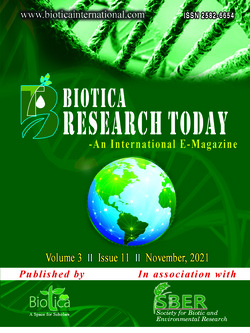
Pigmented Rice: The Colourful Wonder Grain
Rajarshi Sanyal*
School of Genomics and Molecular Breeding, ICAR- Indian Institute of Agricultural Biotechnology, Namkum, Ranchi, Jharkhand (834 003), India
Rachana K.S.
Division of Vegetable Science, ICAR- Indian Agricultural Research Institute, Barhi, Gauria Karma, Jharkhand (825 411), India
Danish Jawed
School of Genomics and Molecular Breeding, ICAR- Indian Institute of Agricultural Biotechnology, Namkum, Ranchi, Jharkhand (834 003), India
Sandeep Kumar
Quality and Productivity Improvement Division, ICAR- Indian Institute of Natural Resins and Gums, Ranchi, Jharkhand (834 010), India
Sujit K. Bishi
School of Genomics and Molecular Breeding, ICAR- Indian Institute of Agricultural Biotechnology, Namkum, Ranchi, Jharkhand (834 003), India
DOI: NIL
Keywords: Antioxidants, Coloured Rice, Nutritional profile, Pigmented Rice
Abstract
Rice exists in different colours such as white, black, red and brown. The most common rice consumed by people is white rice, followed by brown rice. However, rice genotypes with red, purple, or black bran layer have been cultivated for a long time in Asia and Africa. The process of dehulling and milling discards most micronutrients, fatty acids, antioxidants, and fibre. As a result, diets those are over-reliant on white rice risk deficiencies for several nutritional factors. Improving the nutritional quality of rice grains through the modulation of bioactive compounds and micronutrients represents an efficient means of addressing nutritional security in societies that depend heavily on rice as a staple food. Pigmented rice contains a variety of flavones, tannins, phenolics, sterols, oryzanols, and essential oils, which acts as bioactive compounds involved in a wide range of beneficial health effects. It can also have potential use in food and cosmetic industry.
Downloads
not found
Reference
Ghasemzadeh, A., Karbalaii, M., Jaafar, H., Rahmat, A., 2018. Phytochemical constituents, antioxidant activity, and antiproliferative properties of black, red, and brown rice bran. Chemistry Central Journal 12(1), 005-013.
Krishnan, V., Singh, A., Sharma, S., Bollinedi, H., Mabaliranjan, U., Kota, S., Raja, S., Singh, A.K., Praveen, S., 2020. Nutrient dense pigmented rice: A diet for healthier people, ICAR-Indian Agricultural Research Institute, New Delhi, pp. 004-025.
Limtrakul, P., Warathit, S., Sariya, M., 2019. Anthocyanins and proanthocyanidins in natural pigmented rice and their bioactivities. In: Phytochemicals in human health, (Eds.) Rao, V., Mans, D., Rao, L. InTech Open, London, pp. 001-025.
Mbanjo, E.G.N., Kretzschmar, T., Jones, H., Ereful, N., Blanchard, C., Boyd, L.A., Sreenivasulu, N., 2020. The Genetic Basis and Nutritional Benefits of Pigmented Rice Grain. Frontiers in Genetics 11, 215-229.
